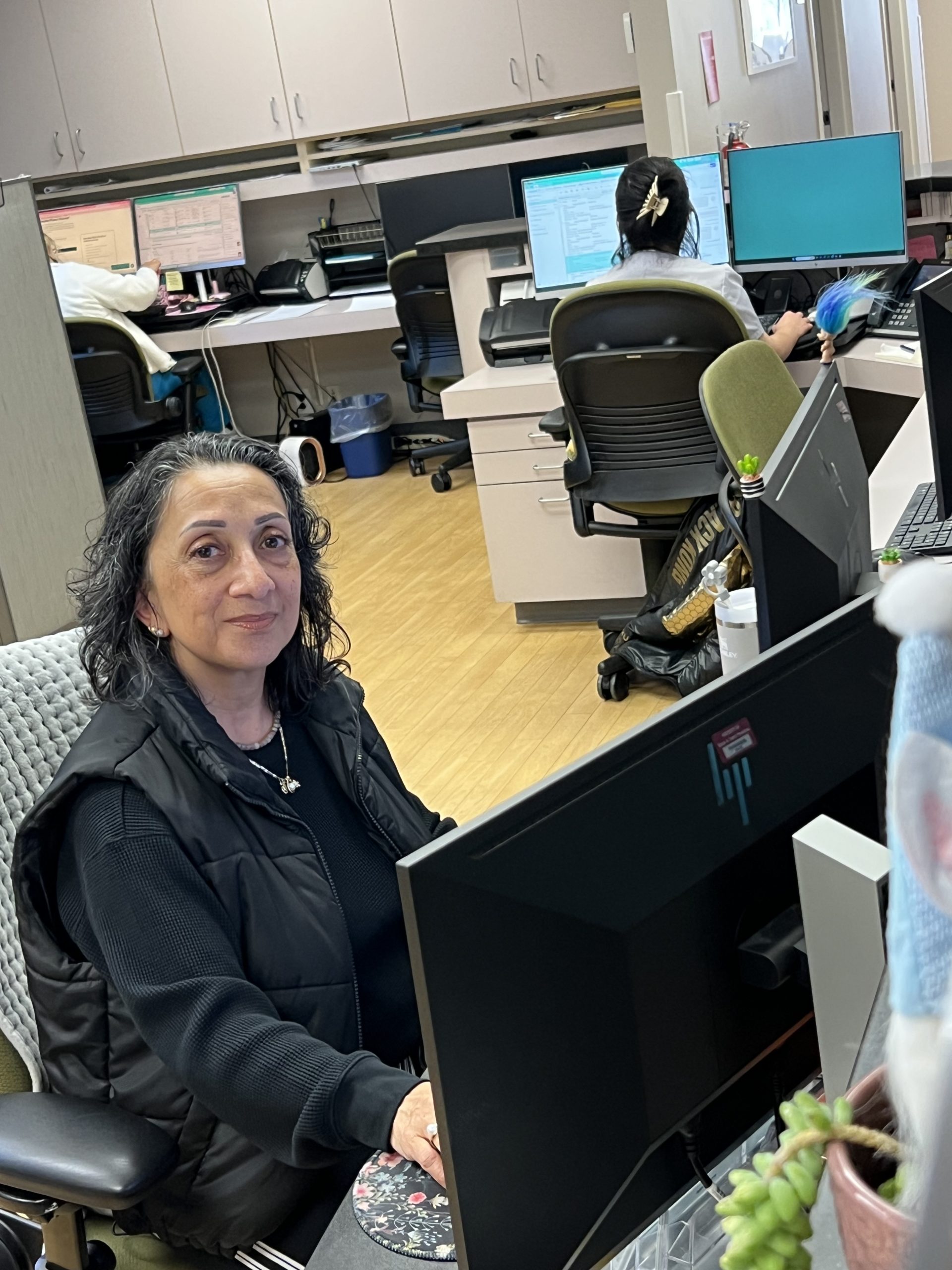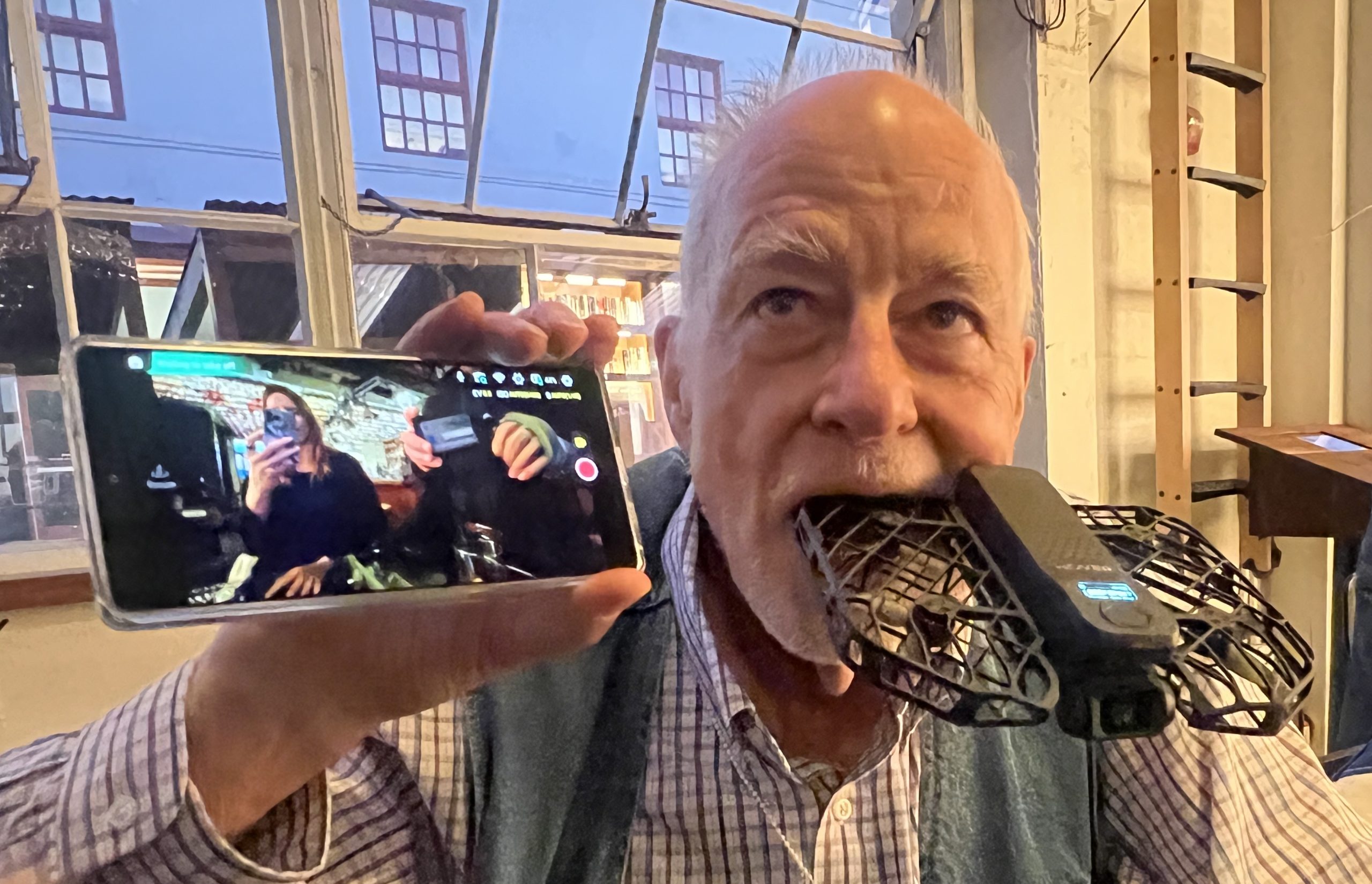Habit started from thrift leads Chinese singer to vintage dress, fabrics career and reunification with her culture
She’s walking down the street in a stunning vintage Chinese outfit and you think she’s off to model in a fashion show. But that’s typical of Terri Wong.
She owns no jeans or sweats. “Since 2013, I have dressed daily in either Chinese or western fashion, or my own knitwear, always with a hat.”
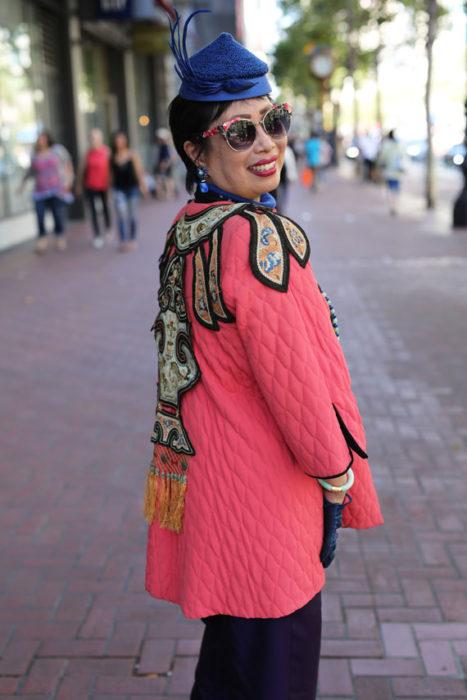
She has worn only antique or vintage outfits since working and going to college, during a short career in opera, while a legal secretary and owner of her own fiber art business and today, as live-in partner to Ken, a jazz sax and flute player. Both are sustaining donors for San Francisco’s Conservatory of Music.
Wong, 64, began to explore her own fashion interests and personal style when she left home at 17. She started with western clothing, and eventually embraced the vintage and antique styles of her heritage.
“The oldest Asian pieces I own are from the late 1800s through the 1930s. My vintage Western pieces date from the 1940s to ’80s,” Wong said.
In general, clothing is deemed vintage if it is at least 20 years old; antique, 100 or more: A dressing gown from the turn of the century might be considered antique. Designer gowns from the 1960s through 1980s might be described as vintage Halston or Dior.
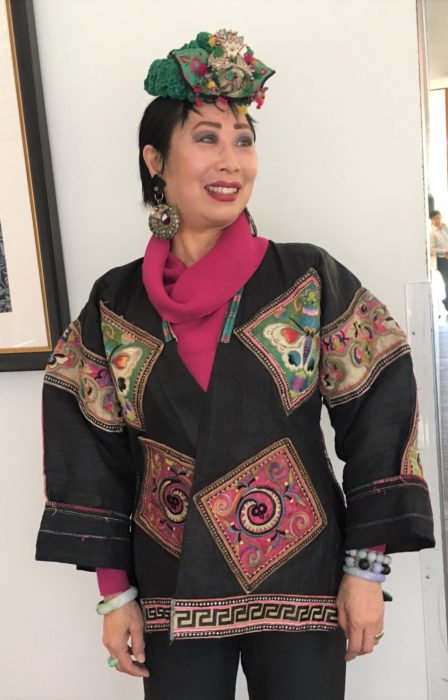
When Wong entered San Francisco State University in 1972, she was also working in public relations, and had to dress the part. “When I was 19, I lost 60 pounds and had nothing to wear.” A friend suggested she shop in the Haight Asbury district, where the prices would fit her budget.
It all started with a good deal
“I walked into the Goodwill and was immediately attracted to the vintage section,” she said. “I bought my first 1950s, bright red cashmere, beaded sweater at the Goodwill in the Haight Asbury district for $10. I still wear it every Christmas.”
Wong is vintage down through her toes. She has a collection of 120 pairs of shoes from the 1940s and ’50s. “Because I have small narrow feet, extra high arches and wear a vintage size 4 up to 5 ½, shoes from those eras fit me perfectly.”
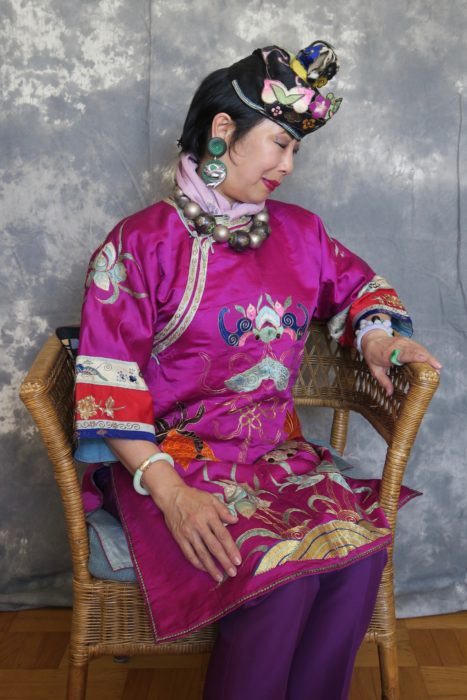
Perhaps it was her artistic nature or romanticism that attracted her to vintage. “I’m not a rebel exactly, but I don’t follow the pack. My choice of clothing allows me to express myself in a way that speaks to who I am.” A favorite quote of hers is by Oscar Wilde: “Be yourself, everyone else is already taken.”
At work, she wore Lilli Ann suits, made in San Francisco in the 1940s. Having been taught to sew by an exacting grandmother, she recognized good workmanship. “The suits have such incredible detail. They hang perfectly and don’t wrinkle. It’s that kind of workmanship young people today don’t understand.”
A love of color, design and good workmanship
Although she hasn’t worn skirts since she stopped working 14 years ago, she’s kept a few of the suits for her vintage collection. On most days, she favors slim-cut, silk capris, which she has in many colors. “I even had a pattern made in case some colors wear out and I can’t buy them anymore.”
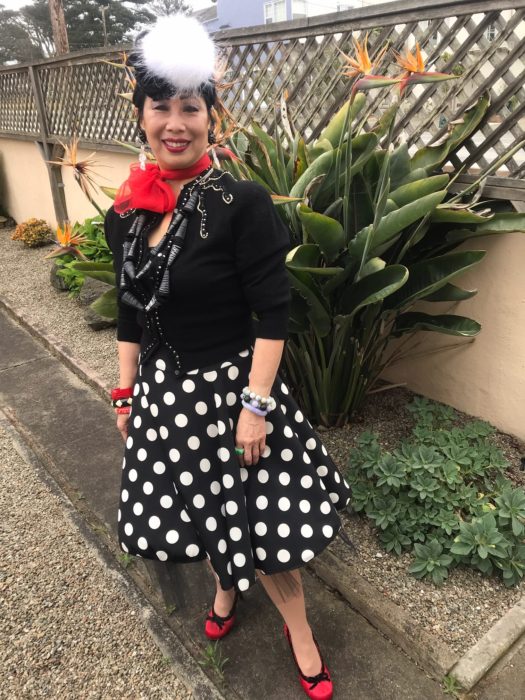
When she first began wearing antique and vintage, Wong was drawn to circle skirts from the 1950s, matching them with the embroidered, beaded sweaters she had been accumulating. Her favorite pairing is her black and white polka dot skirt with sweater and hat. She makes some of her accessories, such as a hat or jewelry. “I made the large pom-pom pillbox as an homage to Audrey Hepburn’s hat in ‘Breakfast at Tiffany’s’.”
A necklace of Peking glass she collected and then assembled garnishes an outfit anchored by a 1930s blue silk print jacket with bell-shaped hem and sleeves. She also made the purple disc hat – “I just kept cutting it down from a huge turban until it felt just right.” The hummingbird earrings were designed by Sally Bass, a friend she met at a trade show whose materials include vintage bakelite and antique Chinese enamel. In Chinese culture, birds symbolize the feminine.
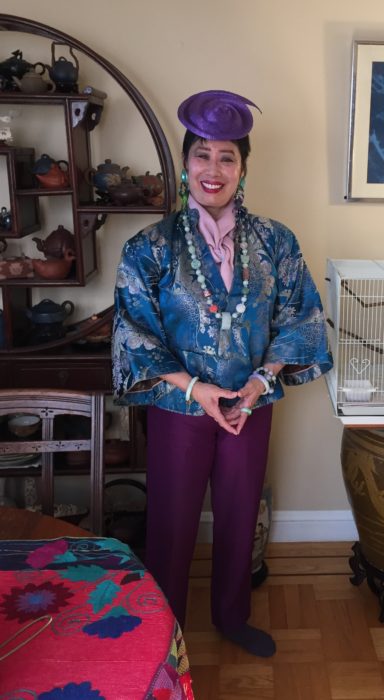
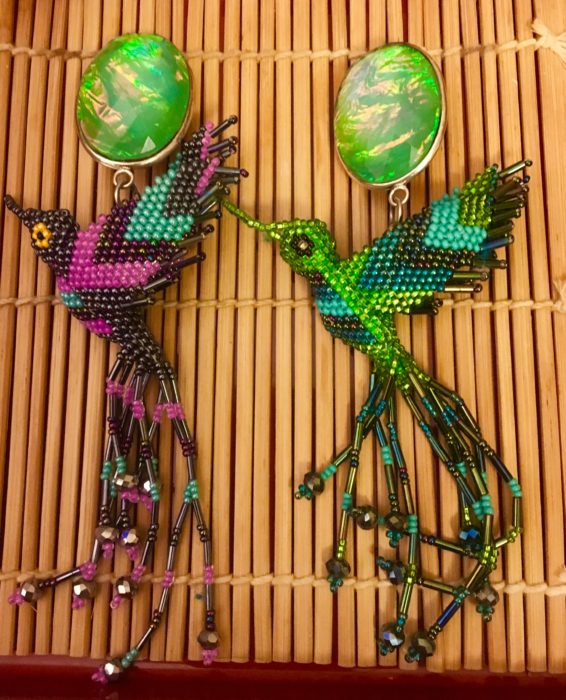
In college, Wong majored in music and developed her soprano voice. She then sang for two years in the chorus with the West Bay Opera in Palo Alto and in two Lamplighter productions. Her fashion sense was also noted. “For La Traviata, the costume designer allowed me to design the ball gown worn by all the women in the chorus,” she said.
From singing to sewing
Wong performed as a soubrette, a type of soprano described as girlish, mischievous, coquettish and gossipy, like the meddling maid Despina in Cosi fan tutte. A divorce forced her to give up opera and find a sustainable career. For the next 25 years, she worked as a legal secretary and paralegal. But she still practices every day to keep her vocal chords humming. “The canary chimes in when he can … he can still out trill me.”
Still needing more artistic outlets, she turned to textiles.
“Longing to express myself, I created a side vocation as a fiber artist, creating knitwear and hats. I also restored antique deco, beaded clothing and Asian textiles.” Wong’s grandmother had taught her to knit, crochet and make lace. “If you can make lace, you can make pretty much anything.”
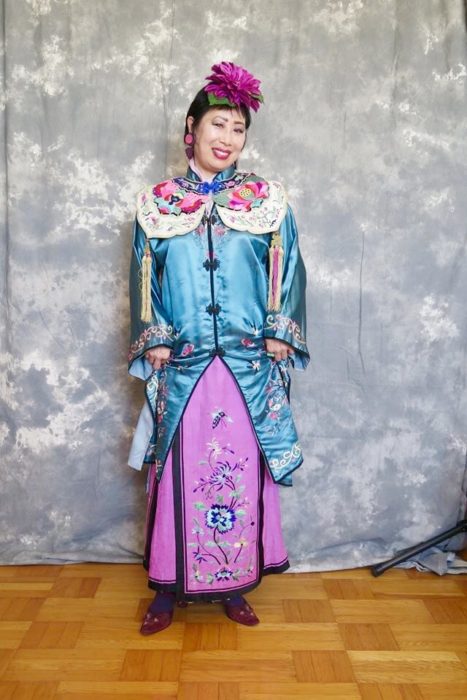
With those talents, Wong launched her new career. Dressed in her finest vintage, she made cold calls on upscale vintage shops in downtown San Francisco. “I walked into shops like Torso Vintage and handed the proprietor my card.’
That got her a group of steady clients and referrals for 35 years. “Sadly, with the demise of brick and mortar, the last of my stores closed two years ago, and with them, the last of my clients.” It was a “great run” while it lasted, she said.
Embracing her culture
Wong began working with Asian textiles after a client asked her to restore a Chinese opera robe. Still, she “didn’t think of wearing my own culture’s vintage clothing until many years after that.” The reason was her association of everything Chinese with her mother’s physical and verbal abuse. “When I worked things out in therapy in my late 50s, I came to understand my mother’s abuse had nothing to do with her being Chinese, but rather with her being mentally ill.”
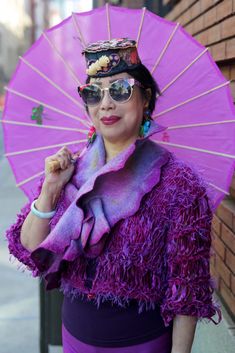
Wong didn’t start actually wearing Chinese vintage until meeting New York City vintage fashion icon Tziporah Salamon. In 2013, a friend sent her a New York Times feature by fashion photographer Bill Cunningham, in which Salamon was pictured. “I looked her up and sent her an email asking her if she’d like to meet if she was ever in San Francisco. She called me the next day and said she was here.”
They met at the Asian Art Museum and have been friends ever since. “Tziporah asked me why I wasn’t wearing Chinese vintage clothing. She said my size four, curvy figure was made for it.” It wasn’t long before Wong started collecting vintage Chinese in Goodwill and on eBay.
Meeting Salamon produced more than friendship. In 2016, Salamon asked her to model her outfits for a book of fashion advice she was putting together featuring women over 50 known for their personal style, “The Art of Dressing Well: Ageless, Timeless, Original Style.”
It was fun, and also “a vindication of all the years of self-doubt stemming from my abuse,” Wong said. “I was humbled by being in the company of the other amazing women models.”
The innovation of Chinese mothers
Some of the outfits she modeled included vintage Chinese childrens’ hats from her collection. She has about 75, and is assembling a photo book through Shutterfly. “These hats, originally only for protecting the head, gradually became whimsical, colorful and joyous folk art,” she said. “Chinese mothers were very innovative, making hats for their children in the shape of animals, birds and boats.
”Her collecting days are not over, but slower. “In these 1930s houses in the Sunset, closet space is at a premium. If one thing comes in, two must leave.”


